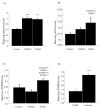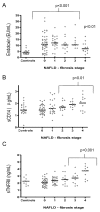Elevated endotoxin levels in non-alcoholic fatty liver disease
- PMID: 20353583
- PMCID: PMC2873499
- DOI: 10.1186/1476-9255-7-15
Elevated endotoxin levels in non-alcoholic fatty liver disease
Abstract
Background: Emerging data indicate that gut-derived endotoxin may contribute to low-grade systemic inflammation in insulin resistant states. This study aimed to examine the importance of serum endotoxin and inflammatory markers in non-alcoholic fatty liver disease (NAFLD) patients, with and without type 2 diabetes mellitus (T2DM), and to explore the effect of treatment with a lipase inhibitor, Orlistat, on their inflammatory status.
Methods: Fasted serum from 155 patients with biopsy proven NAFLD and 23 control subjects were analysed for endotoxin, soluble CD14 (sCD14), soluble tumour necrosis factor receptor II (sTNFRII) and various metabolic parameters. A subgroup of NAFLD patients were re-assessed 6 and 12 months after treatment with diet alone (n = 6) or diet plus Orlistat (n = 8).
Results: Endotoxin levels were significantly higher in patients with NAFLD compared with controls (NAFLD: 10.6(7.8, 14.8) EU/mL; controls: 3.9(3.2, 5.2) EU/mL, p < 0.001); NAFLD alone produced comparable endotoxin levels to T2DM (NAFLD: T2DM: 10.6(5.6, 14.2) EU/mL; non-diabetic: 10.6(8.5, 15.2) EU/mL), whilst a significant correlation between insulin resistance and serum endotoxin was observed (r = 0.27, p = 0.008). Both sCD14 (p < 0.01) and sTNFRII (p < 0.001) increased with severity of fibrosis. A positive correlation was also noted between sTNFRII and sCD14 in the NAFLD subjects (r = 0.29, p = 0.004).Sub-cohort treatment with Orlistat in patients with NAFLD showed significant decreases in ALT (p = 0.006), weight (p = 0.005) and endotoxin (p = 0.004) compared with the NAFLD, non-Orlistat treated control cohort at 6 and 12 months post therapy, respectively.
Conclusions: Endotoxin levels were considerably increased in NAFLD patients, with marked increases noted in early stage fibrosis compared with controls. These results suggest elevated endotoxin may serve as an early indicator of potential liver damage, perhaps negating the need for invasive liver biopsy. As endotoxin may promote insulin resistance and inflammation, interventions aimed at reducing endotoxin levels in NAFLD patients may prove beneficial in reducing inflammatory burden.
Figures



Similar articles
-
Pro-Inflammatory Cytokines but Not Endotoxin-Related Parameters Associate with Disease Severity in Patients with NAFLD.PLoS One. 2016 Dec 19;11(12):e0166048. doi: 10.1371/journal.pone.0166048. eCollection 2016. PLoS One. 2016. PMID: 27992443 Free PMC article.
-
IMPACT OF TYPE 2 DIABETES ON NONALCOHOLIC STEATOHEPATITIS AND ADVANCED FIBROSIS IN PATIENTS WITH NONALCOHOLIC FATTY LIVER DISEASE.Endocr Pract. 2020 Apr;26(4):444-453. doi: 10.4158/EP-2019-0342. Epub 2020 Jan 22. Endocr Pract. 2020. PMID: 31968197
-
Histopathological differences utilizing the nonalcoholic fatty liver disease activity score criteria in diabetic (type 2 diabetes mellitus) and non-diabetic patients with nonalcoholic fatty liver disease.World J Hepatol. 2015 Nov 8;7(25):2610-8. doi: 10.4254/wjh.v7.i25.2610. World J Hepatol. 2015. PMID: 26557954 Free PMC article.
-
Non-Alcoholic Fatty Liver Disease Treatment in Patients with Type 2 Diabetes Mellitus; New Kids on the Block.Curr Vasc Pharmacol. 2020;18(2):172-181. doi: 10.2174/1570161117666190405164313. Curr Vasc Pharmacol. 2020. PMID: 30961499 Review.
-
Non-Alcoholic Fatty Liver Disease in Patients with Type 2 Diabetes Mellitus: A Position Statement of the Fatty Liver Research Group of the Korean Diabetes Association.Diabetes Metab J. 2020 Jun;44(3):382-401. doi: 10.4093/dmj.2020.0010. Epub 2020 May 11. Diabetes Metab J. 2020. PMID: 32431115 Free PMC article. Review.
Cited by
-
Role of Insulin Resistance in MAFLD.Int J Mol Sci. 2021 Apr 16;22(8):4156. doi: 10.3390/ijms22084156. Int J Mol Sci. 2021. PMID: 33923817 Free PMC article. Review.
-
Gut-Liver Axis and Non-Alcoholic Fatty Liver Disease: A Vicious Circle of Dysfunctions Orchestrated by the Gut Microbiome.Biology (Basel). 2022 Nov 6;11(11):1622. doi: 10.3390/biology11111622. Biology (Basel). 2022. PMID: 36358323 Free PMC article. Review.
-
Acute induction of anomalous and amyloidogenic blood clotting by molecular amplification of highly substoichiometric levels of bacterial lipopolysaccharide.J R Soc Interface. 2016 Sep;13(122):20160539. doi: 10.1098/rsif.2016.0539. J R Soc Interface. 2016. PMID: 27605168 Free PMC article.
-
Gut Microbiota-Derived Components and Metabolites in the Progression of Non-Alcoholic Fatty Liver Disease (NAFLD).Nutrients. 2019 Jul 25;11(8):1712. doi: 10.3390/nu11081712. Nutrients. 2019. PMID: 31349604 Free PMC article. Review.
-
Fructose induced endotoxemia in pediatric nonalcoholic Fatty liver disease.Int J Hepatol. 2014;2014:560620. doi: 10.1155/2014/560620. Epub 2014 Sep 28. Int J Hepatol. 2014. PMID: 25328713 Free PMC article.
References
-
- Bellentani S, Saccoccio G, Masutti F, Crocè LS, Brandi G, Sasso F, Cristanini G, Tiribelli C. Prevalence of and risk factors for hepatic steatosis in Northern Italy. Ann Intern Med. 2000;132(2):112–117. - PubMed
LinkOut - more resources
Full Text Sources
Other Literature Sources
Research Materials

